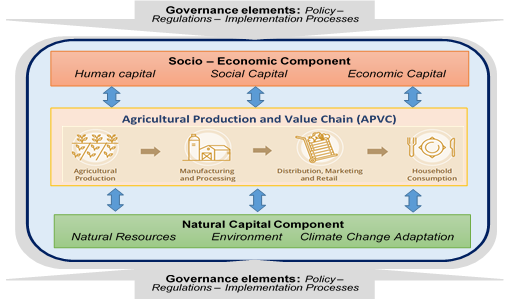Innovations are key to improve the effectiveness of agri-food systems and better meet the rising demand for food worldwide. In particular, they are essential to achieve Sustainable Development Goal 2 targets.
In this context, during 2019-2020, the IFAD independent office of evaluation (IOE) conducted a corporate-level evaluation of IFAD’s support to innovations between 2009 and 2019 (link to the Evaluation report). This was a challenging task, not least because of the varying interpretation of what is an innovation.
The evaluation applied mixed-methods. It analysed 508 loan projects, 240 large grants, and undertook case studies in 20 countries. A systems approach was applied leading to an analytical grid, which includes 4 components (macro domains) of the agri-food system and 12 subcomponents as presented in the Figure below.

Source: Adapted from TEEB (2018), Elements of agri-eco-food system
Defining innovation
The evaluation defines innovation as: “A new way of acting – practice, approach/method, process, product, or rule – brought in or implemented for the first time, considering the context, time frame and stakeholders, with the purpose of improving performance and/or addressing challenge(s). This definition stresses the fact that stakeholders implement innovations aiming at enhancing the performance of agri-food systems.
Key lessons from the evaluation
The evaluation revealed the benefits of implementing innovations as a ‘bundle’. This approach refers to the packaging of innovations of different types, such as innovations in production, with new ways of organizing farmers and links to finance. Bundling innovations allows tackling the many challenges faced by smallholder farmers simultaneously. This affords innovation packages a transformative dimension, as they are able to lift poor farmers above the poverty threshold, and help ensure that they do not fall back after a shock. Moreover, while a stand-alone innovation may work well, it may not be sufficient in the face of an important crisis (e.g. drought or price collapse).
Stemming from the above, although the evaluation found few examples of bundling, a key lesson is to choose innovations that can work in synergy with each other. Particularly in the case of the inclusion of women, youth or disadvantaged groups, fewer inputs can achieve better impacts when innovations are bundled with a combination of access to resources, capacity building and social measures.
By nature, innovation involves taking risks; which may not always lead to success. In the case of loan-supported projects, implementing partners favour risk-adverse innovations, avoiding genuinely novel solutions that entail a risk of failure. Against this backdrop, the evaluation highlighted the need to facilitate organizational culture shifts vis-à-vis innovation in order to support genuinely novel solutions with potential for failure. This may include specific funding to encourage innovative initiatives, as well as targeted capacity building for staff and rewards (financial or otherwise) to recognize innovation champions.
Effective knowledge management and sharing are critical to support processes of innovation promotion and their integration, as well as scaling up, into national or regional innovation systems and programmes. Information should be specific, should focus on innovation results and lessons, and should be collected and shared in a consistent and systemic fashion.
Examples of transformative innovative solutions
One example of innovation is the Society for Intensification of Agricultural Production (SIPA), introduced in Senegal with an IFAD-supported project in the early 2000s. SIPAs are small and medium rural enterprises specialized in modern and intensive agricultural production for commercial purposes. Each SIPA builds human and social capital for an intensive agricultural production (on an area of approximately 40-50 ha) of commercial commodities, and using improved technologies (certified seeds, irrigation schemes and mechanization). Between 100 and 150 people benefit on average. The project supports initial investments, with government subventions and institutional support, including by guaranteeing access to credit. The market access was guaranteed by securing upstream purchasing contracts with private companies, leading to effective marketing and sale. The success of this innovative approach, that addressed both low productivity and rural unemployment in semi-arid areas, led the Government to secure funds to scale up it.
Another example is the Gender Action and Learning System (GALS), a community-led household methodology that aims to give women and men more control over their personal, household, community and organizational development. Applied through IFAD’s support in several countries (e.g. Kirgizstan, Rwanda, etc.), it intended to empower women by bundling access to resources, capacity building and social support for transformative impacts. The work begins with training of ‘change catalysts’ or ‘champions’ at community level; they then work at household level to support the family (all members) to analyse their current situation – including gender inequalities – in order to address current constraints and develop a shared vision for them and the household’s future development of an action plan. GALS was successful to enabling households and communities to reflect on their current situation in relation to the opportunities and barriers faced by women and men and to adapt the techniques to fit local conditions (eg. literacy, communication).
A last example was in found Indonesia, where cocoa diseases and soil impoverishment affected negatively cocoa smallholder farmers. Stakeholders invested in research, breeding better resistant varieties, as well as in training farmers, who were then able to act as “cocoa doctors”, identifying cocoa diseases and raising healthy cocoa seedlings in nurseries. Cocoa doctors were supported with a small grant to expand their activities; revolving funds were implemented to increase the purchasing power of cocoa farmers groups, while they were encouraged to improve their farms on their own terms. Extension services’ efforts were enhanced to organize farmer field schools for this crop, which was formerly poorly addressed. All these have been profitable for all parties. Decision makers at national level were then included in the process through a policy lab, which was able to monitor these innovative interventions in order to assess them and scale them up.
